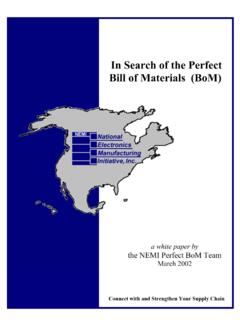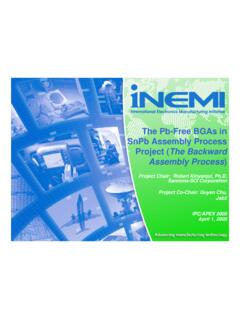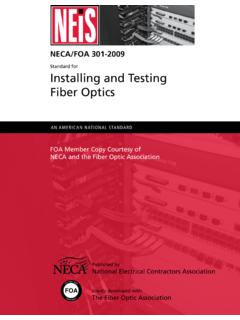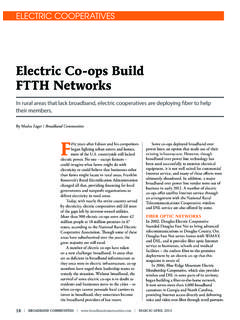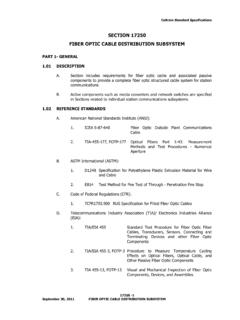Transcription of Insertion Loss Measurement of Low Loss Fiber Optic Splices
1 Insertion loss Measurement of Low loss Fiber Optic SplicesNEMI Fiber Optic Splice Improvement , Aurora; P. Arrowsmith and R. Suurmann, Celestica; D. Gignac, Nortel Networks;S. Pradhan, Sanmina-SCI; J. Garren, Solectron; T. Watanabe, Sumitomo Electric; and E. Mies, VytranABSTRACTR esults from a National Electronics Manufacturing Initiative (NEMI) project, formed to improve aspects of Fiber Optic fusionsplicing, are reported. The focus of this paper is ultra low loss splicing for telecommunications product assembly, withtypical loss of < dB per splice for standard SMF-SMF.
2 A detailed review of available industry standards, relevant tosplice loss acceptance criteria and loss test procedures, revealed the standards are generally inadequate for low loss project participants using different equipment and procedures performed Fiber preparation, splicing, splicer lossestimation, and actual loss measurements. An industry standard gage repeatability and reproducibility (GR&R) analysis wasused to compare the data. loss Measurement set-ups based on a cutback method for dissimilar Fiber (SMF-EDF) splicesshowed significant directionality in some cases, and root cause was identified using a round robin approach.
3 Several of themethods evaluated will form the basis for a new loss Measurement standard for low- loss and dissimilar Fiber many Optoelectonic manufacturing (OEM) applications, such as EDFA assembly, the ability to fabricate low loss fusionsplices is critical for proper function of the optical circuit. Splice loss requirements of less than dB are common. Whilethe interdependence of the factors that that cause variability in splice loss have been reported [1-3], at these very low lossrequirements, the Measurement uncertainty can be a significant problem in determining whether or not a splice is it is usually not possible or practical to perform actual splice loss measurements during production builds, it istypically necessary to rely on the loss estimation provided by the splicer.
4 To assess the accuracy of splice loss estimators atthese low loss levels, a Measurement system must be capable of repeatability and reproducibility (R&R) value of 10% of therange, or dB. Further Measurement uncertainty arises in dissimilar Fiber Splices , where directionality can be practical aspects of how to achieve repeatable measurements for low- loss similar and dissimilar Fiber Splices were themain drivers for forming a National Electronics Manufacturing Initiative (NEMI) member project in mid-2002. Acomprehensive review and gap analysis of industry standards relating to splice loss acceptance and test methods revealed thatmost of these standards were developed for outside plant (field) splicing applications, where loss ranges of over dB wereacceptable.
5 [4] While TIA 455-34A [5] comes closest towards addressing the needs for a precision loss measurementmethod, there are important omissions for OEM splicing, Measurement methods for splicing dissimilar fibers, such asSMF to EDF. The objectives of the NEMI project are to assess the repeatability of different Measurement methods and set-ups, and to incorporate the best practices in draft standards for adoption by the appropriate industry organizations. Use ofcommon test methods will enable comparison of splice losses and splicing equipment between vendors and users, andpotentially lead to improvement in the accuracy of loss estimators and better splice yield for low loss METHODOLOGYGage R&R Test MethodTo quantify and compare the capability of current splice loss test methods, a gage repeatability and reproducibility (GR&R)study [6] was conducted on several optical test system using various loss ranges and Fiber types.
6 This investigation requiredthe production of 5-10 Splices for a given process range. Each splice was measured three times, using 1-3 operators in arandom order, resulting in 3-9 measurements per splice. The spliced Fiber was moved between each Measurement tointroduce any additional variation that would normally occur during the splice. This data was then used to determine themeasurement R&R by calculating the 99% spread of this distribution, taking into account both the equipment and appraiservariation represented by each data set.
7 The Measurement spread divided by the Measurement range (either the actual range ora defined process or tolerance range) gives the gage R&R. The Measurement system should ideally provide a percent R&R-value of 10% for acceptable discrimination, 10-30% for marginal and >30% GR&R for poor. [6] loss Measurement MethodsTechniques commonly used to measure splice loss include an optical power source and meter, or an optical time domainreflectometer (OTDR). There are many variations possible when using a power source and meter, but in general they fallinto one of two categories: the in-line method, Figure 1, where the Fiber ends remain fixed throughout the entire testingprocess, or the or the cutback method, Figure 2, where the connection to the power meter is changed during themeasurement.
8 For this paper we refer to the cutback method as the Bare Fiber Adaptor (BFA) method, in reference to theneed for connecting a free Fiber end into the power meter detector. Both methods begin with setting up a reference Fiber , thenmeasuring the splice loss compared to the reference. If the Fiber under test has significant loss , compensation must beincluded. The test methods used in this study, summarized in Table 1, were further divided between those that accommodatesimilar and dissimilar fibers. Dissimilar fibers typically have different mode field diameters (MFD), which can result insignificant contribution to the splice loss , according to Equation 1 [7, 8].
9 There are several setup variations that may make both the in-line and BFA methods more repeatable. These include usingcladding mode strippers (per TIA 455-34A), external isolators and securing fibers to prevent unnecessary movement. Withinthe BFA measurements, distinction was also made between systems that incorporated an integrating sphere (IS), whichideally removes any Measurement dependence on how the Fiber is coupled to the 1. In-line method (I) for similar fibers (BFA and IS optional)Figure 2. BFA method (B) setup for measuring dissimilar fibers in two directions (SMF and EDF shown)Table 1.
10 Splice loss Measurement methodsLoss TestMethodFiberType(s)ProcedureAttribute sIn-line (I)SimilarSee Fig. 1. Initial setup consists of a reference Fiber between an opticalsource and a power meter. The system is allowed to stabilize, the meter swavelength is matched to the source and the meter referenced. The Fiber iscut and spliced back together, with the new power meter readingrepresenting the splice loss . [9] Fiber ends at source and detectorremain fixed not FiberAdapter (BFA) cut-back (B)Similar ordissimilarSee Fig. 2. Fiber end at the power meter is prepared and inserted into theBFA.

